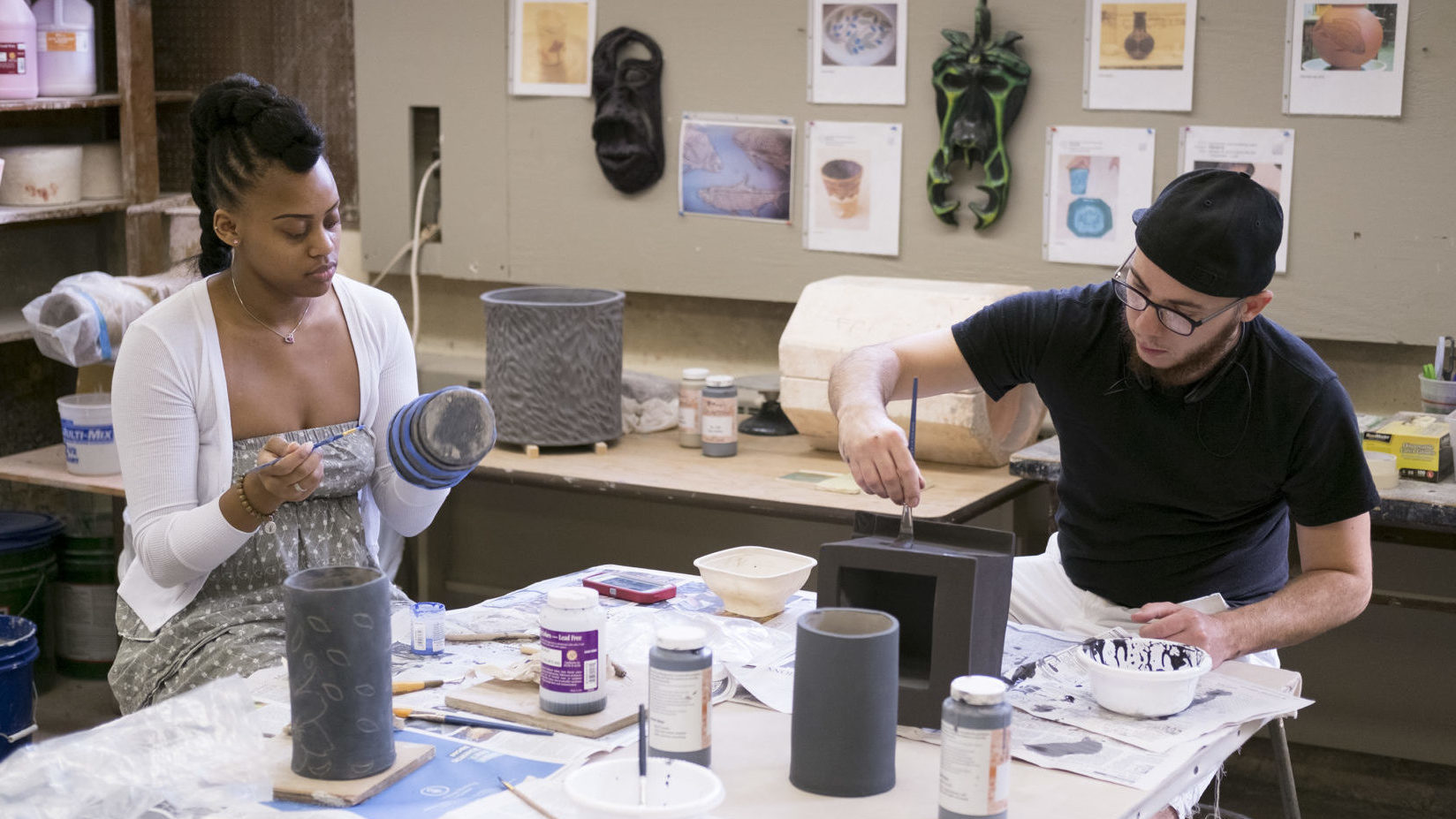Ceramics
Hazards associated with ceramics are related to three aspects of the process: preparing and molding the clay, glazing, and firing the clay. Below is a list of precautions and informational table describing the potential hazards associated with different ceramic processes. For further information, review the Material Safety Data Sheet (MSDS), for the products being used, particularly glazing compounds, which may contain some highly toxic compounds. The MSDS will provide data such as physical properties, toxicity, reactivity, etc. MSDS sheets are produced by the company that manufacture the product(s) and are available either in the classroom, through WCSU's Environmental Health and Safety website or they can be found online by searching for MSDS of the particular products.

Ceramics Precautions for Students
- If possible, avoid exposure to clay dust by purchasing pre-mixed clay. If you mix your own clay, the mixer should have local exhaust ventilation and be equipped with appropriate machine guards to prevent access to moving parts while operating. Consider wearing a respirator when mixing clay.
- When lifting heavy items such as bags of clay, clay additives, or glazing compounds, use appropriate lifting techniques, get help from another person, or use mechanical aids. Raise your potter’s wheel so you can work in an upright position.
- Use asbestos-free talcs. Regularly wet mop, hose down, or vacuum (with a HEPA vacuum) the studio—particularly the dry mixing area—to remove potentially toxic dust such as silica and heavy metals. Do not allow spilled clay to dry; it can be crumble into an airborne dust.
- Purchase prepared glazes without toxic components whenever possible. If you do use or mix glazes containing highly toxic metals such as lead, cadmium, arsenic, or uranium, your institution must meet the applicable OSHA regulations.
- If you mix your own glazes, wear gloves. Mix glazes under local exhaust ventilation or wear a respirator. Avoid spraying techniques that will aerosolize the glazes. Instead, brush or drip glaze on your clay. If you must use spraying techniques, use a paint spray booth.
- Because your hands become contaminated while working, do not eat, drink, or smoke in the studio. Wash your hands thoroughly when you finish working or leave the studio. Good personal hygiene is one of the most important ways you can reduce your exposure.
- Regularly apply hand cream to replace lost oils and to keep your hands from drying out. Cover cuts or other broken skin with gloves to prevent infections
- Wear a full-length smock or coveralls in the studio and do not wear them outside the studio. Wash them frequently and separately from other clothing.
- Wear a disposable smock or coveralls if working with toxic metals. Remove the smock or coveralls before leaving the studio and dispose of in your institution’s designated hazardous material container.
- All kilns must be locally exhausted and vented to the outside. Keep combustible materials, particularly flammable materials, away from kilns. Small kilns should be raised at least a foot off the floor with a refractory brick placed underneath. Keep a fire extinguisher close by and know how to use it.
- Wear appropriate shaded eye protection when looking directly into the kiln.
Activity
Mixing dry clay
Material
Dry clay
Potential Hazard
Clay contains crystalline silica, which if inhaled over the course of many years can lead to the debilitating lung disease silicosis. Symptoms are similar to asthma: a form of silicosis is called "potter's asthma". Loading and mixing dry clay in a clay mixer creates the most likely opportunity for exposure to the silica-containing clay dust.
Mixing dry clay
Talc
Talc added to clay may be contaminated with asbestos or “asbestos-like” fibers. Mixing dry clay Clay mixer, bulk materials Like all mechanical equipment, clay mixers have moving parts that could catch your
Mixing dry clay
Clay mixer, bulk materials
Like all mechanical equipment, clay mixers have moving parts that could catch your hand or arm if you reach into it while it is operating. Bags of dry clay and clay additives are heavy; repeated lifting can cause back injuries.
Handling wet clay
Wet clay, potter’s wheel
Wet clay is a growth medium for mold and other microorganisms that can cause allergies and infections of the skin or nail beds. Mold can aggravate some pre-existing medical conditions such as asthma. Working with clay for extended periods of time on a potter’s wheel can lead to a repetitive trauma disorder of the hand or wrist.
Glazing
Glaze
Glazes are mixtures of silica, alumina, metal fluxes (such as lead, barium, lithium, calcium, or sodium), and colorants. Some colorants contain highly toxic metals such as lead, cadmium, chromium, uranium, and arsenic. These metals should not be used in school programs if at all possible because safer substitutes are available. Many prepared glazes contain frits which are created by melting various glaze ingredients into a glass and grinding them into a powder. Frits containing toxic metals are hazardous and should be handled with caution since they can leach into the body over time and should not be used.
Firing Kiln
Clay
During the firing process, clay releases combustion products and gases whether using a fuel-fired or electric kiln. These emissions include carbon monoxide, formaldehyde, sulfur oxides, chlorine, fluorine, metal fume, and nitrogen oxides. Unless ventilation is excellent, metal fume particles such as lead and cadmium can settle and contaminate other ware and surfaces. In addition, fuel-fired kilns release the products of combustion from their fuel sources.
Firing Kiln
Clay
Infrared radiation emanates from hot (glowing) fired ceramics and can cause cataracts after long periods of exposure. Unloading hot objects from a kiln can cause burns.

